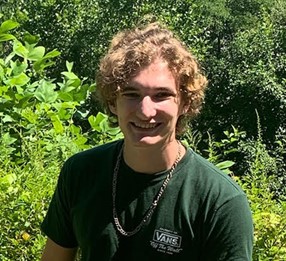The award was initiated in 2021 by former ChBE Department Chair Mayuresh Kothare and is funded by donations to the Department of Chemical and Biomolecular Engineering (ChBE) at Lehigh University from sponsors Eric Gustafson and Kimberly Grassi, wife of Lehigh ChBE alumnus and former colleague Vincent Grassi. It is their shared desire that this award helps to catalyze undergraduate ChBE students continued active involvement in research for years to come in their professional career.
Students are selected annually by the ChBE Undergraduate Curriculum Committee led by Professor Angela Brown. As part of the award, students have the chance to participate in several research-focused opportunities over the summer. Students also participate in the annual ChBE Research Symposium held in the fall. The generosity of the respective donors whose support enables their summer research experience positively impacts the training of ChBE undergraduate students and creates a unique Lehigh experience for each one of them.
This year’s awardees are Shengping Huang, David Kramer, and Megan Stratton. Each award recipient has shared a synopsis of their summer research project experience.
Shengping Huang: Plastic(polyethylene) has been overly produced and used worldwide because of its resilient and lightweight properties. Human lives have become more convenient because of the usage of plastic. However, the large amounts of plastic waste left are starting to cause problems. Until now, over 7.4 billion metric tons of plastics are in the earth’s system. Less than 10% of plastics are recycled worldwide because making new plastic costs less than recycling plastic waste. It is important to recycle or upcycle plastic. One of the methods to depolymerize polyethylene is an organic reaction called olefin cross-metathesis. With sacrificial alkane (pentane in our case) added, olefin cross-metathesis can break down longer polyethylene into a distribution of shorter alkanes. In our research, we want to learn about the most plausible reaction pathways to break down polyethylene and their thermodynamics. However, the reaction networks could be extremely complicated. To help us solve this problem, machine learning and cheminformatics are utilized. For example, RING (Rule Input Network Generator) is used to generate all the possible reaction networks. RDkit, the cheminformatics, is used to generate possible conformers of each molecule. ANI-1, a neural network, is used to calculate the potential energy of each molecule. We have a workflow from generating the reaction network to determining which pathways are the most plausible by their thermodynamics. In the future, we are going to try analyzing other reactants other than plastic, for example, rubber. Also, we want to try to analyze the effect of adding functional groups to polyethylene using metathesis.
David Kramer: My research, which was conducted in the lab of ChBE Professor James Gilchrist, and under the guidance of Dr. Samuel Wilson-Whitford, investigated the physics of Janus particles. Janus particles are small (>1mm), and they are special because one or both hemispheres of the particle is functionalized- or manufactured in a way to provide different physical properties on either side. Our particles are functionalized on one side using iron, which essentially made the particles behave like little magnets. Therefore, we can manipulate the particles using exterior magnetic fields. The specific topic I was researching related to Janus particles was how they can be utilized to enhance transport through a porous medium (like soil). To test these properties, I created samples in which the substrate was gel beads. The particles were “rolled” through the sample via a wheel with four bar magnets attached to it, which was suspended above the sample. Our apparatus applied a torque to each Janus particle within the sample, causing them to move, when ordinarily, they would remain stationary. We were able to prove that this indeed is an effective method of enhancing transport in porous systems- and this type of research has implications in various fields, such as in medicine- where “microrollers” are already studied as a method of medicine delivery, environmental applications, like cleaning up hazardous waste spills, and even in reactor/catalyst design. "This research was incredibly rewarding, as I could immediately see the effects of any manipulations to the system and I gained invaluable experience" says Kramer. "Doing this research gave me direction."
Megan Stratton: Chronic skin wounds are a major healthcare issue that have increased the need for treatment methods to be developed and implemented into clinical care. Stem cell therapy has proven to be a valuable treatment option due to their ability to differentiate into other types of cells, aiding in recovery of damaged tissues. To be inserted within the body, they need to be manually deactivated and inserted within a hydrogel, compatible with the composition of the human body. In wound healing, pro-inflammatory and anti-inflammatory cytokines are naturally released to help direct and regulate stem cell motility. Within the lab of ChBE Professor Kelly Schultz, I aided in measuring cell-material interactions in synthetic hydrogels, as well as determining the change of human mesenchymal stem cell (hMSC) motility and pericellular degradation when cytokines appear within wound environments. The design of existing hydrogel scaffolds targets the direct tissue which needs repair but fails to account for the environment surrounding it. My work focused on assessing the effectiveness of varied hydrogel components through creation of a cell gradient. Through the creation of a 3D printed microfluidic chamber, I measured the ability of fluorescent dye to diffuse through hydrogel, which will create a gradient that impacts cell movement. I also assisted with cell tracking through multiple particle tracking (MPT), which is a technique that takes the mean squared displacement of embedded probe particles as they move within cells overtime, helping to characterize changes in a cell's microenvironment. Through MATLAB and Igor software in the MPT process, I was able to generate a value which determined the state of the gel that the cells were contained in.
Department/Program:



